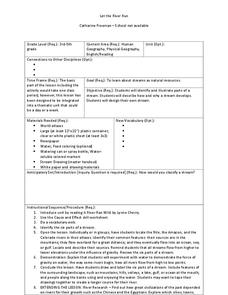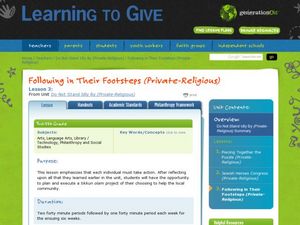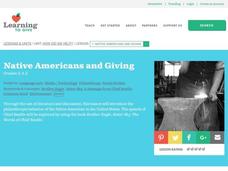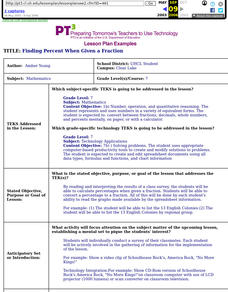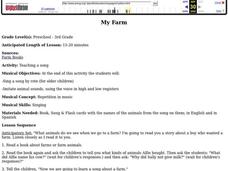Curated OER
Review of Adjectives
The easiest way to learn how to use adjectives is through practice, practice, practice! Print out pictures of people and various objects, and have pairs attempt to describe the items together. This plan suggests providing laminated index...
Curated OER
Avoir, Être, et Le Passé Composé
The lesson begins with direct instruction: how and when do we use avoir and être to form the past tense? After identifying the verbs that use either avoir or être, French learners write about five things they did the week prior. Then, in...
Curated OER
Folk Tales for ESL Students
Using the folk tale "The Man, The Boy, and The Donkey" (linked in the lesson) and a SMART board, teachers can help pupils access multiple skills. Reading the story allows learners to create a timeline of the sequence of events based on...
Curated OER
Let the River Run
Learners explore the environment by reading a story in class. In this water formation lesson, students define environmental terms such as rivers, streams, gulf, oceans and lakes. Learners read the story A River Ran Wild and discuss the...
Curated OER
Diminutivos
There are several reasons why Spanish speakers use the diminutive form. Not only is it used to indicate size, but it can also indicate affection. This plan, while not incredibly detailed, does provide some great questions for...
Curated OER
Future Actions
How do you conjugate a reflexive verb? This plan suggests reading a children's book to your intermediate Spanish speakers. Follow the reading with a PowerPoint slide show that presents reflexive verbs, a sentence using the verb, and a...
Curated OER
Following in Their Footsteps (Private-Religious)
Students serve in their community. For this community action lesson, students read "First They Came for the Jews" and discuss what happened when people didn't take ethical action. Students discuss the actions they could take to help in...
Curated OER
Following in Their Footsteps
Students explore the concept of philanthropy. In this service learning lesson, students reflect upon the lesson of tikkun olam as they read "First They Came for the Jews." Students plan and execute a tikkun olam project of their choosing...
Curated OER
Spaghetti Graphs
Students work in pairs to test the strength of spaghetti strands. They collect and graph data to determine a line of best fit. Students create a linear equation to interpret their data. Based on the data collected, students predict...
Curated OER
The First Conservationists
Students read a story. In this Native American lesson, students learn about Native Americans and their responsibility to take care of a place called Turtle Island. Students learn the vocabulary words generation, befall, interdependence...
Curated OER
Inch By Inch
Students explore the concept of measuring length using a one-inch pipe cleaner "inchworm." They listen to the story "Inch By Inch by Leo Lionni and discuss how the animals were measured by the inchworm in the book. In pairs students...
Curated OER
Temperature (Celsius)
Third graders solve Celsius and Fahrenheit conversion problems, watch weather forecast and convert temperatures to Celsius, and design and present their own weather forecasts for different regions based on information gathered from...
Curated OER
Native Americans and Giving
Students explore the concept of philanthropy. In this Brother Eagle, Sister Sky: The Words of Chief Seattle lesson, students examine the plight of Native Americans and explore Native Americans' quest for the "common good."
Curated OER
Michigan History of Philanthropy
Middle schoolers investigate how philanthropy began in Michigan. In this philanthropy lesson, students read Michigan History of Philanthropy and read a timeline of several events. Middle schoolers create a picture with a sentence about a...
Curated OER
Breakfast for Champions
Students prepare an event to honor philanthropic activities in their community. In this common good lesson, students send out invitations to local non-profits or to those who engage in philanthropic activities and plan an awards...
Curated OER
Finding Percent When Given A Fraction
Seventh graders calculate percentages when given a fraction. They convert a percentage to a fraction. All of this be done by each student's ability to read the graphs made available by the spreadsheet information.
Curated OER
Desert Biome
Pupils examine the vocabulary of desert animals and observe pictures of the animals as they name them. As a class, students compare and contrast the characteristics of desert animals. Using a specified website, pupils match pictures of...
Curated OER
Review Geometry Week
Fifth graders participate in a review game of geometry topics. In this geometry lesson, 5th graders use the "Eggspert" interactive classroom game system to review the geometry skills taught that week. Students work in teams to complete...
Curated OER
British Colonization-Settling the Thirteen Colonies (1607-1733)
Students study the thirteen colonies: geography, economics, politics, and religious groups. They explore early colonial life, and create a travel brochure, travel guide of the 13 Colonies, and word search.
Curated OER
Planet Research and Brochure
Fourth graders design a brochure based on the planet that they researched. In this planets lesson plan, 4th graders include the data, important facts, and completed as a team.
Curated OER
Sacred Giving- Why?
Middle schoolers define the Jewish concept of tzedakah. In this religious lesson, students read portions of the Torah and discuss the meaning of tzedakah. Middle schoolers visit a Jewish Community Center.
Curated OER
My Farm
Students explore repetition in music. In this music lesson, students discover the lyrics of a folk song from Argentina about farm animals. Students read about farms and the animals found on farms prior to learning the song in high and...
Curated OER
Mexican birthdays
Third graders examine "Compleaños Feliz" and the symbolism of the pinata associated with birthday parties.
Curated OER
Doing Our Share Lesson 1: Michigan History of Philanthropy
Students research the history of philanthropy in Michigan by looking at images and pictures while discussing the definition of philanthropy. They design a picture of the first time they saw a philanthropic act and write three sentences...



